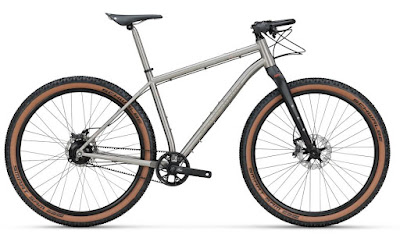At that time, in the early-to-mid-1990s, mountain bike frames like my Jamis Dakota typically had 71 degree head angles, which are a bit more slack than road frames (73-74 degrees) but more aggressive than ‘80’s machines that, like the balloon-tired bikes from which they evolved—and many of today’s “hauler” and “rough stuff” bikes—had angles ranging from 69 all the way down to 66 degrees.
Bikes like my old Dakota, I believe, were attempts to inject some road-bike responsiveness into mountain bikes, some of which were, frankly, sluggish. But those bikes from three decades ago were comfortable and stable enough that they were often used for loaded touring (sometimes after switching the flat handlebars for dropped bars), as Trek and other bike-makers stopped making dedicated touring bikes around 1988.
Well, someone at the Dutch bike company Van Nicholas seems to have ridden—or simply recalls—one of those mountain bikes. Their new Nootau, billed as “the ultimate bike-packing machine,” is built around a titanium frame with a geometry nearly identical to a just-before-suspension off-road bike.
Of course, the Nootau’s componentry has almost nothing in common with what was in use around the time “Smells Like Teen Spirit” blasted across the airwaves. Like most of today’s new bikes, it has a threadless headset and stem, which were available but not standard. But, unlike the cantilever brakes on vintage mountain bikes, disc brakes stop the Nootau. Discs enjoyed brief popularity, mainly on tandems, during the late 1970s and have been revamped during the past few years.
Perhaps the most striking difference, however, between the Nootau’s equipment and that of vintage mountain bikes is in the drivetrain: the Nootau has no derailleurs. Instead, its single-sprocket crankset is mated to a Rohloff rear hub with 14 internal gears. (I’m trying to wrap my head around that: I’ve had Sturmey Archer and Shimano three- and five-soeed internally-geared hubs.
I may not have the opportunity to ride a Van Nicholas Nootau. I must say that I like its look—and relish the irony of how much its design resembles that of my old Jamis Dakota.


